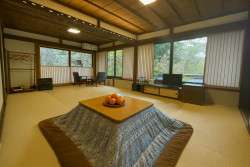
March 5, 2014
The Half-Life of Anti-Nuclear Protest
As public outcry subsides, voices both for and against nuclear energy rises
By Metropolis
TENT

At the crossroads outside the Ministry of Economy, Trade and Industry (METI) building in Kasumigaseki three large tents draped in antinuclear slogans are blocked off from the road by waist-high signs reading: “State-owned land. With the exception of authorized persons, entrance is forbidden.” Placed in front of the signs are an array of colourful potted plants and three cinder blocks in order for people to easily step over the barriers.
The tents have been a focal point for the protests since they were first erected in September 2011.
During a protest marking six months since the earthquake, four young students on a hunger strike and a group of men in their 60s and 70s chose the spot for two reasons: proximity to the ministry responsible for the reactor restarts and distance from any police headquarters. Over time it’s evolved into a conglomerate of several groups with a monthly organizational meeting and an established chain of command during emergencies. Their two goals are to prevent the restart of nuclear reactors and to assist those affected by the disaster in receiving adequate compensation.
Inside the 20-square-meter main tent a dozen seats surround a small table and shelving units overflowing with books and plastic boxes line the two sides. A curtain separates an area at the back where, during the night, two six-hour sleeping shifts are taken from 9pm to 3am and 3am to 9am. Each night half of the group “on duty” sleep while the other half keep watch. Summer nights are unbearably hot and humid, while the winter brings chilling winds that beat emphatically against the outside of the tent and sweep through the gaps in the entrance. A sliding wooden door installed in January has improved insulation, but the temperature remains only marginally warmer than outside. Thick communal clothing, jokingly referred to as “share wear,” helps keep the group warm.

One man who is seemingly unaffected by the cold is Masahide Kimura, who strolled in from the snowy outdoors wearing a pair of traditional wooden Japanese sandals on the night Metropolis visited the tent. A couple of group members introduced him as a leader but he dismissed the notion with a good-natured smile and insisted on equality. He was returning from the fifth oral proceeding regarding a lawsuit filed by METI and his high spirits were juxtaposed by their lawyer who took a seat in the corner, looking preoccupied. If they lose, the tent will be removed and Taro Fuchigami and Taichi Masakiyo (two defendants selected simply because they signed a letter from the group to the ministry) will be charged rental for the land the tents are occupying, land which they insist is public space. When the suit was first filed the amount was ¥11 million. It currently stands at ¥15 million and will continue to rise until the matter is settled, though their lawyer doesn’t expect that will be until next year. Regardless of the result, they consider the lawsuit a success in that METI was finally forced to acknowledge them.
Over 4,000 people nationwide are involved with the tent in some way, but the core group that maintains it has diminished to less than 30 and it’s sometimes difficult for them to cover the weekday “shifts.” In the time passed since the disaster, many have reluctantly gone back to their regular lives and jobs, others have had to deal with illness or worse. In one corner of the room is a framed photograph of a member who died of karoshi, or death from overwork and mental stress. “He worked too hard,” one of the group explained before another added, “And drank too much.”
Setsuo Fujiwara, 64, says that returning to work isn’t a problem for him, as he has no job to go back to. Four years ago, he was working as a nuclear safety inspector and was ordered to cover up his poor evaluation of a power plant in Hokkaido. He refused and became a whistleblower, eventually leading to a termination which was later deemed unlawful. 88-year-old Michiko Saito, who regularly takes shifts at the tent in a “no nukes” sweater and a hat bearing the group’s Japanese characters, was also an anti-nuclear power activist before the disaster. Her first protest was over 40 years ago, at a time when she says there were around 250 other individual activists but no organization to unite them. Just a few hundred yards from where the tent stands today, she turned up at the gates of the ministry with two friends only to be laughed at and told, “Come back when you have more people.”
Over the past few years she’s done exactly that, often returning with the thousands of other protesters that gather around the ministry and Diet building every Friday. To mark the disaster’s third anniversary, a large-scale demonstration in Tokyo has been scheduled for March 9. Perhaps its attendance will give a clearer picture of whether the capital really has forgotten the events of 2011.
Louise Rouse contributed translations to this article.







